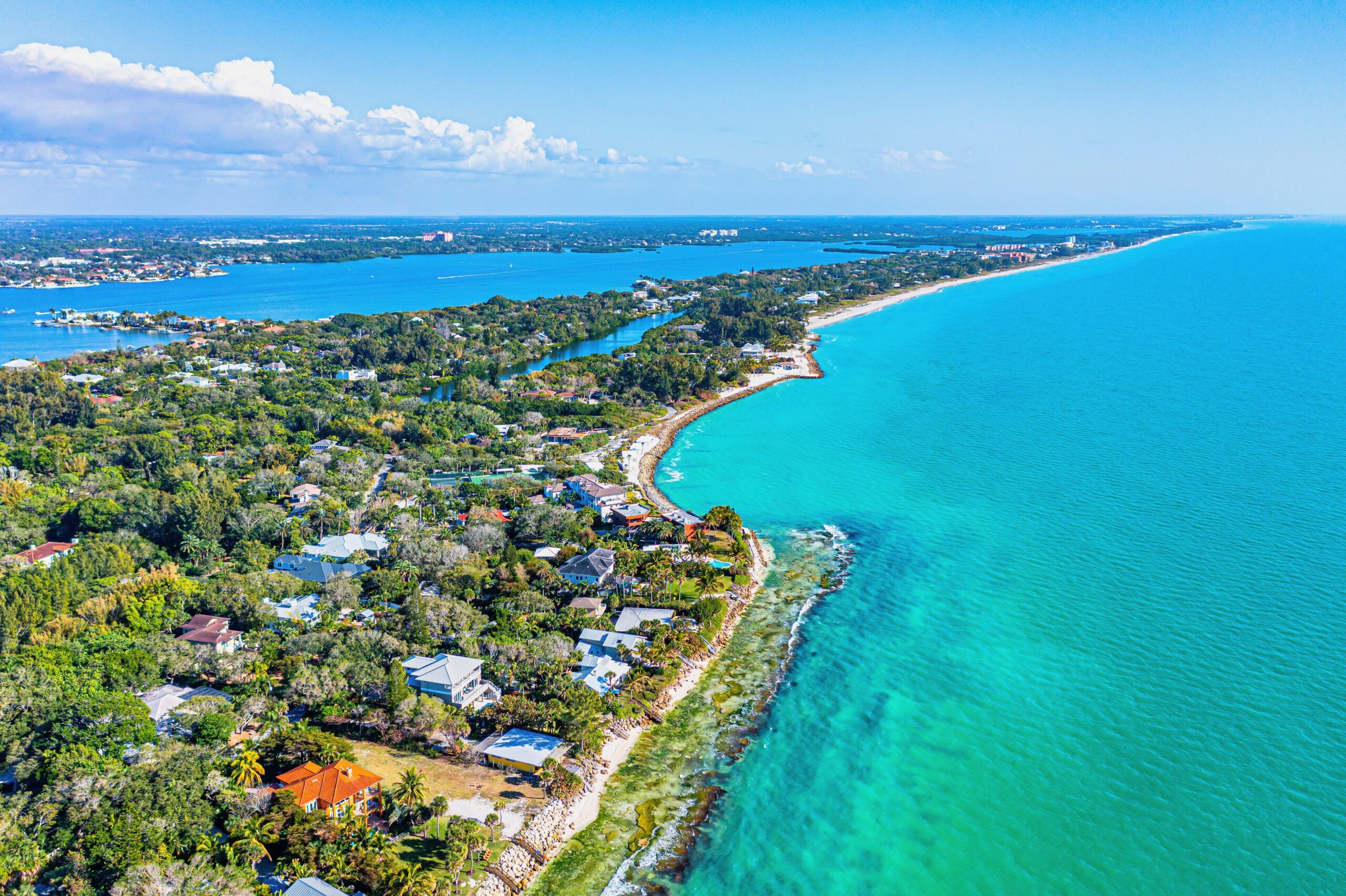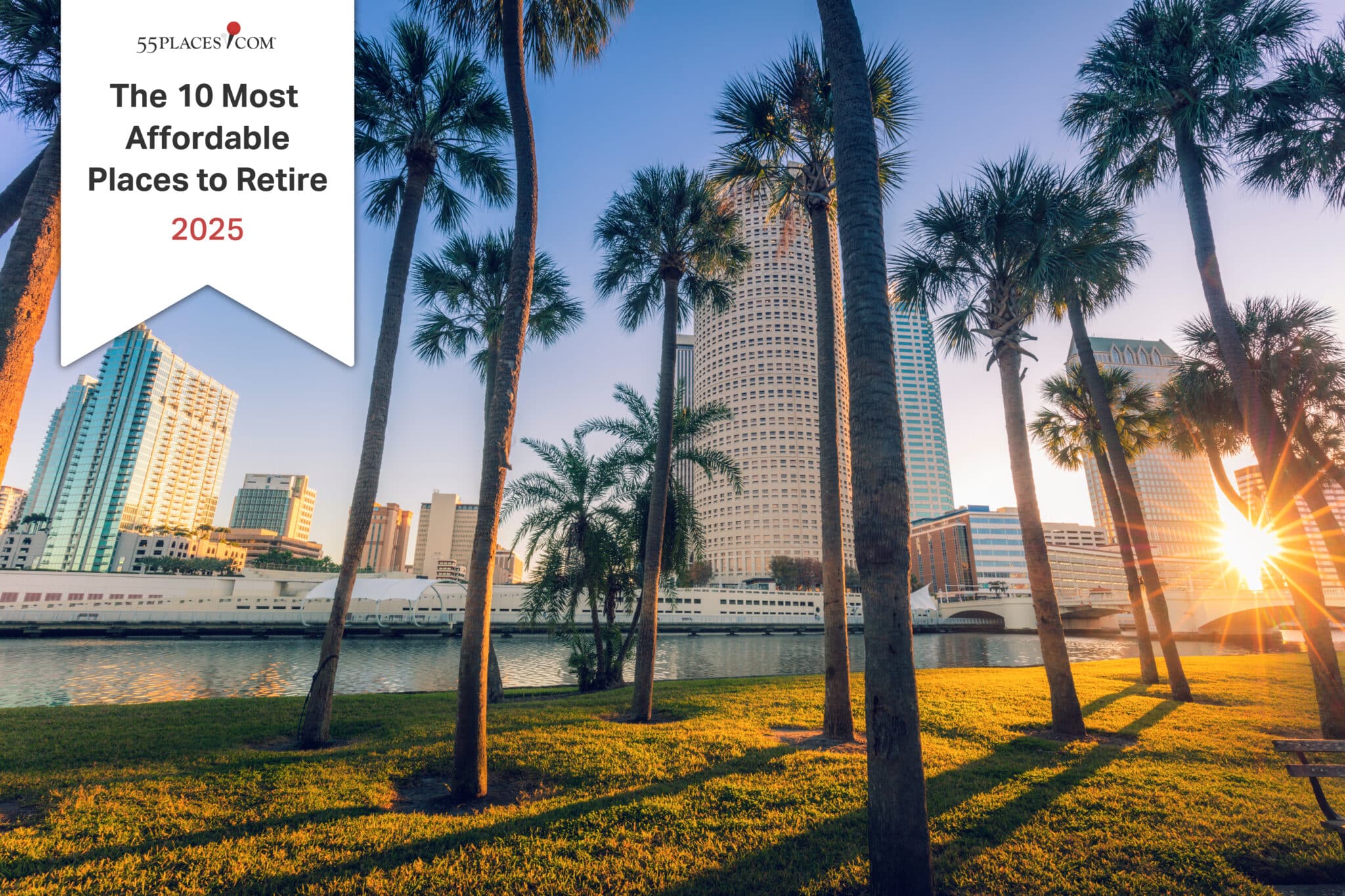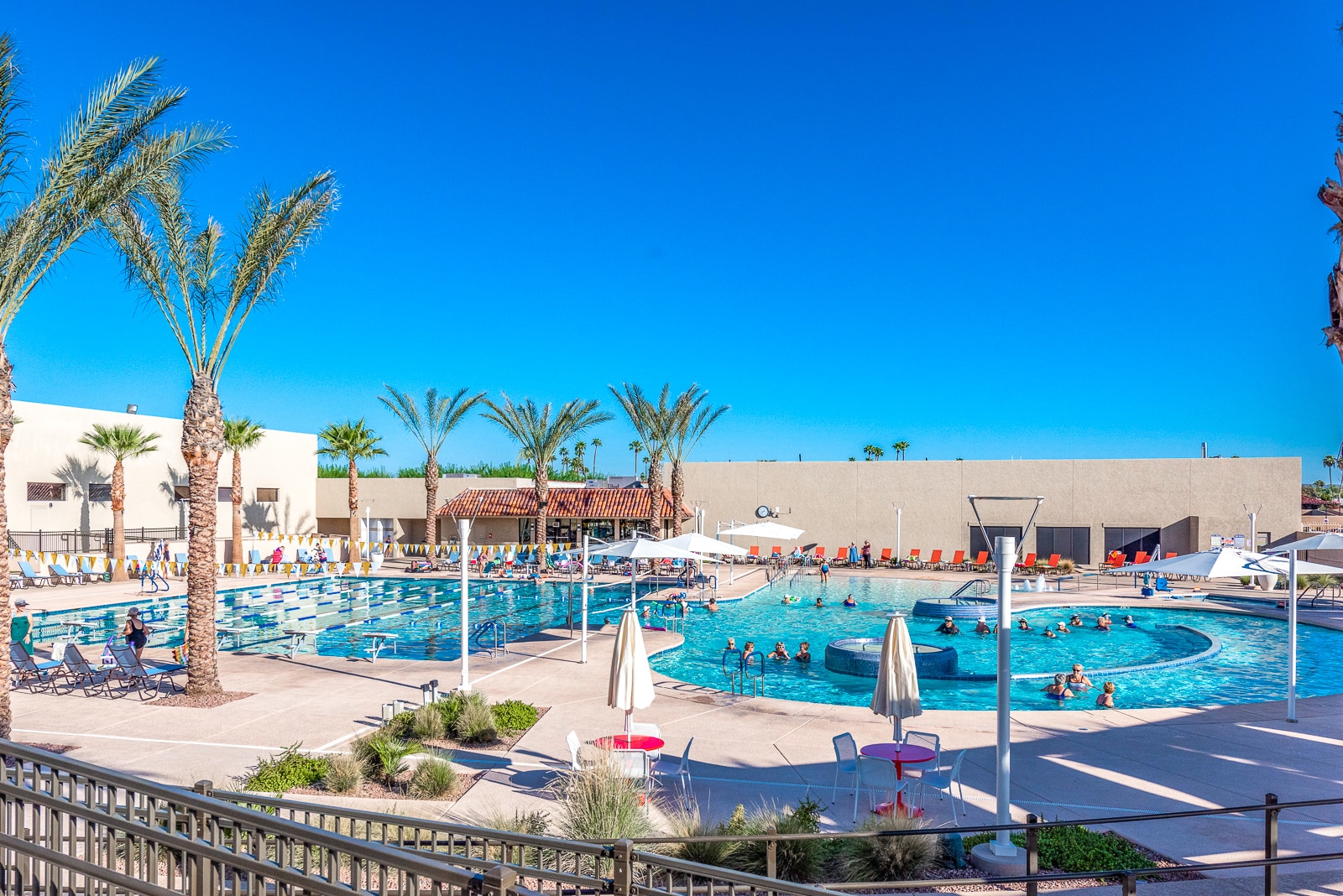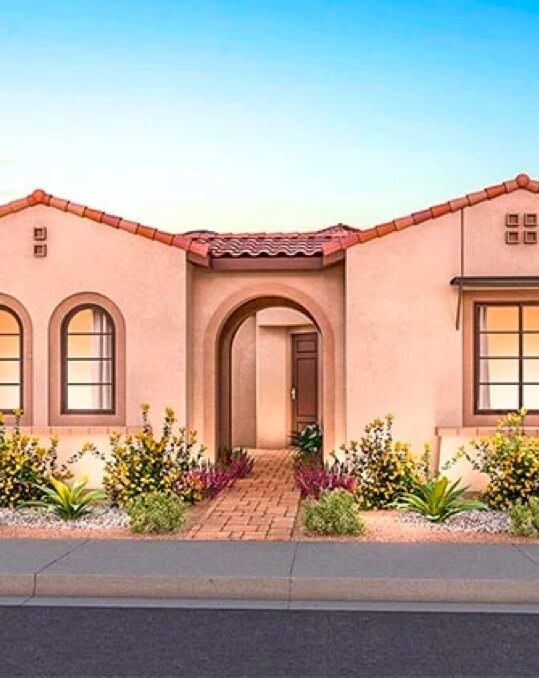Are you thinking about retiring on Florida’s Gulf Coast?
Florida’s western shoreline is renowned for its silky-sand beaches, abundant natural outdoor recreation and wildlife, and the numerous cities and communities that offer excellent restaurants, entertainment, art, culture, and easy access to airports and highways. Each city is unique, from Pensacola in the north to Venice in the south.
This is an all-inclusive resource for what Florida’s Gulf Coast has to offer retirees, from lifestyle options to affordability. We’ll examine hotspots like Sarasota, Tampa, and Fort Myers, offering a range of options that showcase the best places for active adults to retire on Florida’s Gulf Coast.
Let’s take a look at what you’ll find on this side of the Sunshine State!
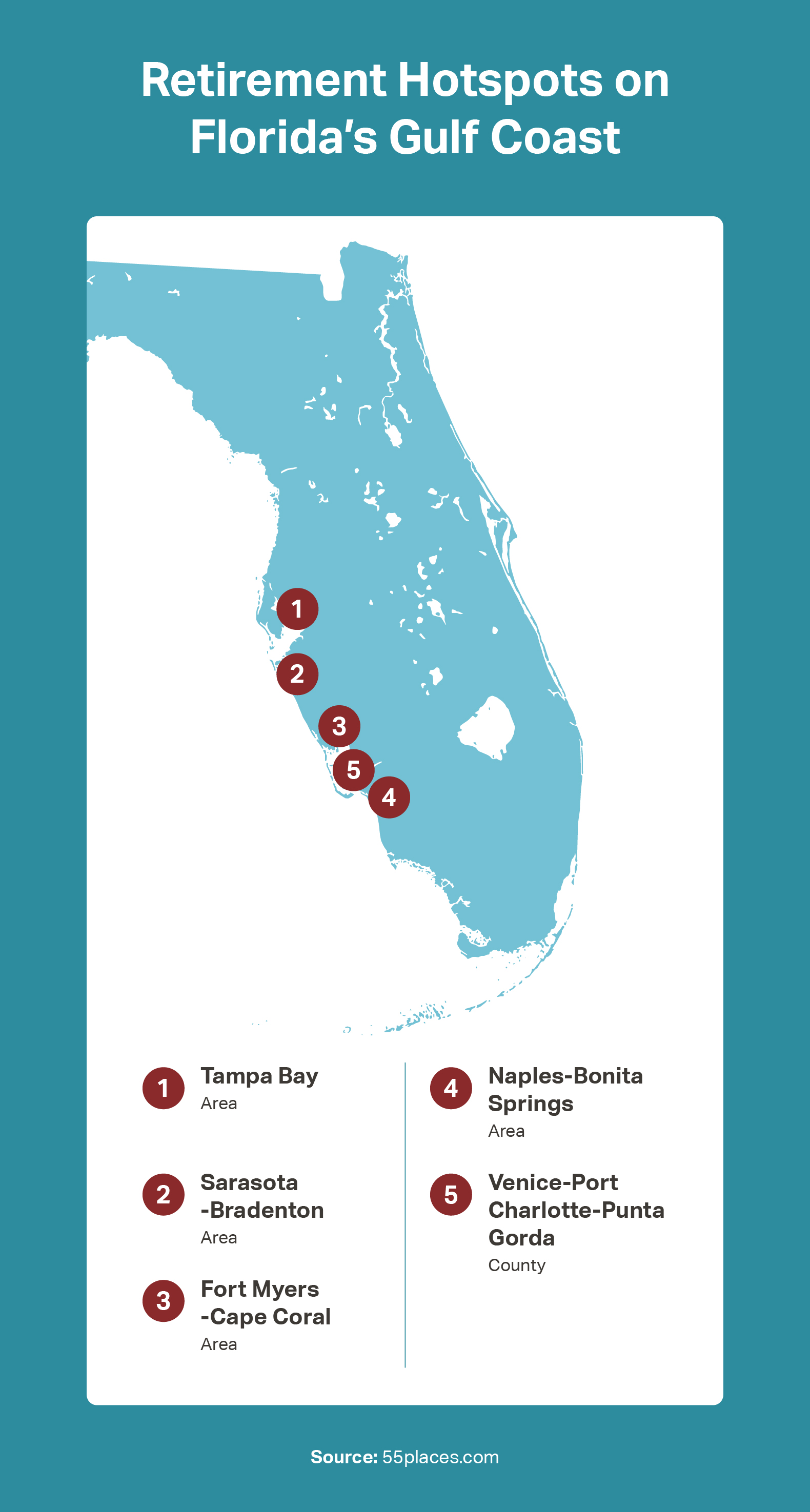
Florida’s Gulf Coast: A Retirement Demographic Snapshot
The Gulf Coast of Florida has experienced a surge in population over the last five years, not only in major metropolitan areas like Tampa and Sarasota, but also in the Panhandle. Recent news and U.S. Census reports have shown that the Panama City metropolitan area is one of the fastest-growing in the country. Also, one million snowbirds are estimated to visit Florida between November and April every year, and Gulf Coast cities are some of the spots they’re making their second home.
When it comes to like-minded neighbors, a large part of this area’s population is approaching retirement age. In Sarasota County, for example, the average age is 57. In Collier County, where Naples is located, the average age is 53. And it’s 48.9 in Pinellas County—inclusive of St. Petersburg and Clearwater.
A reasonable cost of living and no state income tax attract many retirees to the Gulf Coast. According to 2023 data, the median income of Florida residents aged 65 and older was $56,005. Gulf Coast counties, such as Collier, Hillsborough, and Sarasota, have median incomes that are notably higher than the state average. But for retirees on a budget, there are still good deals to be found, even as home values continue to rise statewide.
What It’s Like to Retire on Florida’s Gulf Coast

The Gulf Coast of Florida attracts retirees because it offers a lifestyle that’s both active and relaxing. It’s a slower pace in this part of Florida than what might be found in Miami or cities along the Atlantic Coast.
Larger cities like Tampa and Sarasota still offer all the advantages of city living, but with less congestion and stress. This is especially attractive to residents who do not want the traffic, crowds, and extra noise that can be found in some of the state’s larger cities.
What to Expect from the Climate
Winters are mild on Florida’s Gulf Coast. Occasionally, there’s a drop in temperatures and even a brief freeze, particularly along the northern Gulf Coast and into the Panhandle, but there’s rarely a need for heavy coats and boots. Summers are hot, and residents unaccustomed to this heat must ensure their homes are well-insulated, air-conditioned, and comfortable. While heating bills are extremely low during the winter, costs to cool a home can rise during the long, intense summers.
The downside to this idyllic weather is the risk of hurricanes. Unfortunately, it doesn’t take a direct hit to cause flooding, wind damage, and power outages. Hurricane Season runs from June 1 to November 30, and residents here know to take it seriously. The most active time of year is late August and into September. It doesn’t have to be a hurricane; tropical weather of any kind can be dangerous and disruptive. It’s a good idea to invest in things like hurricane shutters or impact-resistant windows.
Additional Resources:
- The Best Places To Retire in Florida Without Hurricanes
- Weathering the Storm: Does an HOA Cover Hurricane Damage?
- The Most Affordable Places to Snowbird in Florida
- Fresh Alternatives to Florida for Retirement
Outdoor Living Is the Norm
Life is lived outdoors for most of the year. Thanks to mild winters and summer breezes off the Gulf, residents and retirees golf in January and enjoy outdoor dining throughout all the seasons. Restaurant patios are equipped with both heat lamps for those cool winter nights and fans for those hot summer days.
The local geography supports outdoor living and a diverse range of recreational activities. From beaches to hiking trails to freshwater fishing spots, the outdoors are always calling. Pickleball and golf are available in nearly every area, and there’s always an opportunity for a long walk, a leisurely bike ride, or some simple sunset watching. Beach piers in cities like Venice and Clearwater attract a consistent crowd as the day turns to night and the bright orange sun seems to dip into the water.
Culture and Art on the Florida Gulf Coast
Gulf Coast communities are renowned for their arts, outdoor festivals, and exceptional cuisine. Consider the museum scene. In Sarasota, the Ringling Museum of Art offers a European ambiance, making visitors feel as though they’re in Europe. There’s the Salvador Dalí Museum in St. Petersburg, and it’s an astonishing collection of original works and curated exhibits. The Sidney & Berne Davis Art Center in Fort Myers is renowned for showcasing local artists as well as international talents, and also hosts concerts, featuring a rooftop bar.
Professional sports are also available, with the Tampa Bay Buccaneers taking central Gulf Coast residents through football season and numerous spring training teams arriving in the area ahead of baseball season.
Naples is renowned for hosting numerous festivals throughout the year, including the Naples National Art Fair, the Naples International Film Festival, and the Stone Crab Festival. Speaking of food, fine dining is a big deal on Florida’s Gulf Coast. In Tampa, Bern’s Steakhouse is consistently rated one of the best restaurants in America, and it hosts a wine fest every spring. The USS Nemo Restaurant in Naples specializes in seafood. It’s not all fine dining; many excellent pizza places, burger joints, and sandwich shops can also be found in the little neighborhoods that make up each city and town on this side of the state.
Pros and Cons of Gulf Coast Living
Challenges are found in the high heat and humidity of summer, ongoing hurricane anxiety, and the additional costs that come with this risk, particularly when considering insurance premiums and emergency planning. There’s also the overall popularity of living in Florida that can sometimes lead to overcrowding, even on the Gulf Coast.
It’s not only retirees who are eagerly relocating to Florida; the entire state has seen an increase in population numbers across age groups over the last five or six years. This has driven up pricing and increased demand for homes. Some communities have been playing catch-up in terms of services, schools, roads, and other infrastructure requirements.
However, the Gulf Coast offers the retirement lifestyle that many new residents are seeking. There’s a lot to do, some great weather to enjoy, and an abundance of 55+ communities that make it easy for people to make friends, explore new hobbies, and enjoy a high quality of life. It’s easy to find a neighborhood that’s near the water, on a golf course, or close to nature and wildlife. Quality of life is high on Florida’s Gulf Coast, and it’s due to more than just the weather. People tend to like where they live, which contributes to a wholesome and happy environment.
Additional Resources:
- The 5 Best Florida Gulf Coast Beaches for Active Adults
- What Is the Retirement Age in Florida?
- Why Do People Retire in Florida?
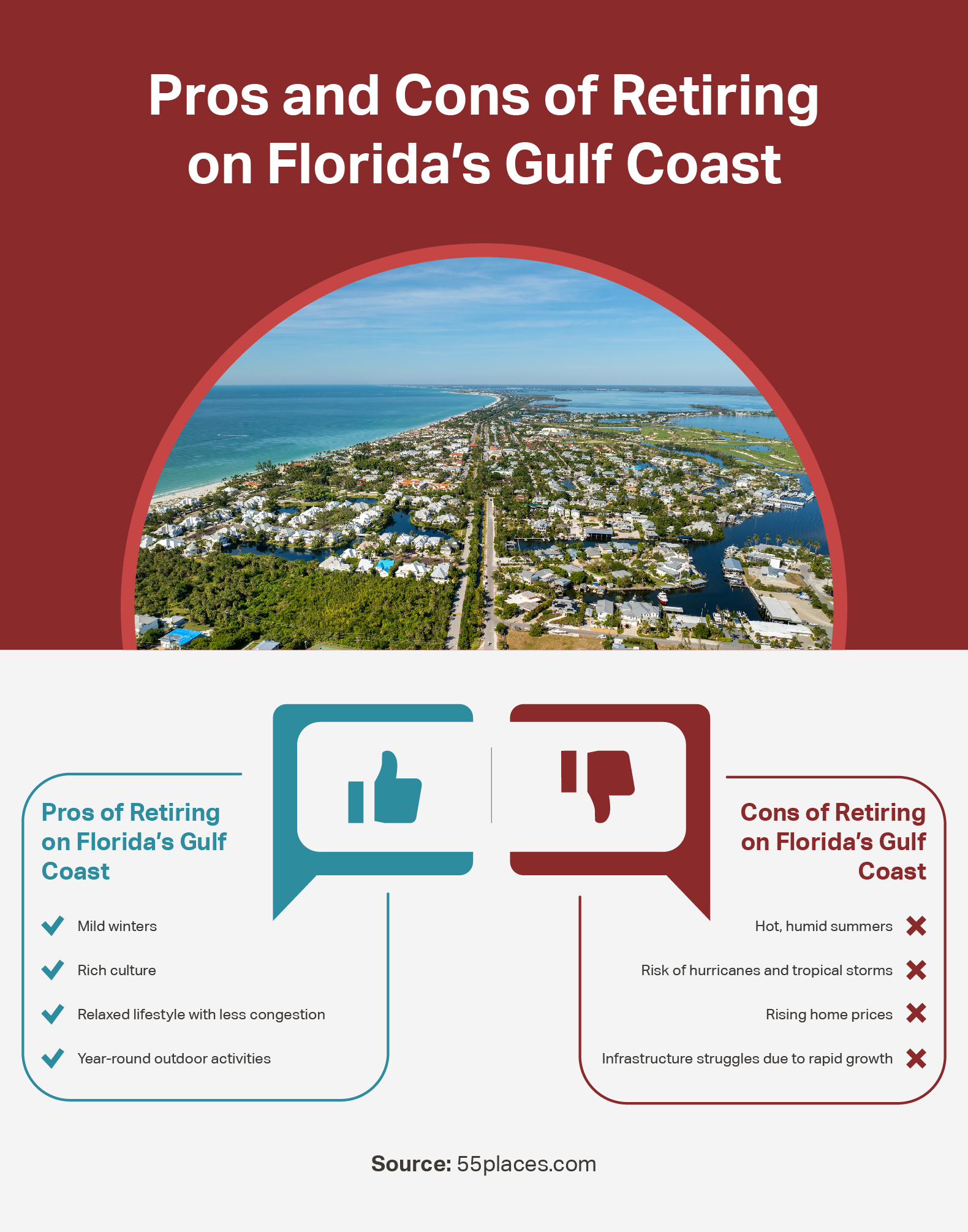
Best Places to Retire on the Gulf Coast
According to the Florida Department of Environmental Protection, the state’s Gulf Coast covers 825 miles of shoreline. That’s a long stretch of land, with dozens of cities and hundreds of towns offering potential places to live. As you plan your retirement, which part is going to be the place that you call home?
Let’s take a look at what you’ll find as you begin exploring.
Tampa Bay Area
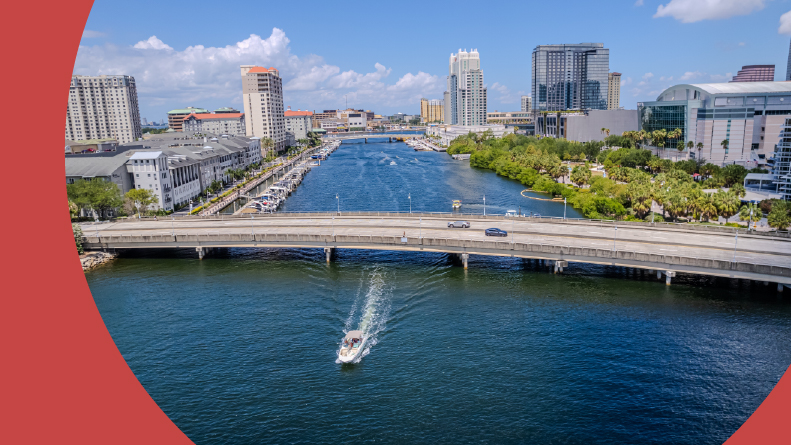
When we talk about the Tampa Bay area, we’re talking about Tampa, St. Petersburg, Clearwater, and Dunedin. There are also numerous growing areas, such as Spring Hill, Land O’Lakes, and New Port Richey. Sun City Center, situated south of Tampa, is renowned for its active adult communities and golf cart-friendly neighborhoods. Here’s what to consider about Tampa and its surrounding areas.
What Retirees Love About the Tampa Bay Area
Tampa International Airport (TPA) offers daily flights to cities throughout the country. International flights are also available. The airport is small, well-designed, and manageable, making it an ideal choice and helping residents avoid the larger airports in Miami and Orlando. Also, some of the state’s best hospitals and health care centers are in and around Tampa, including Moffitt Cancer Center in Tampa and Baycare’s Morton Plant Hospital in Clearwater.
The Tampa area boasts over 100 golf courses, and local professional sports teams include the Buccaneers (football), Lightning (hockey), Rays (baseball), and Rowdies (soccer). Plenty of museums, art galleries, waterfront walkways, and excellent restaurants can be found in this part of Florida. We’ve mentioned the Dali Museum, and on the Hillsborough River, there’s also the Tampa Museum of Art.
What’s Life Like in the Tampa Bay Area?
The arts and entertainment scene in Tampa Bay is lively and diverse. Not only are there museums and restaurants with a view, but there are also shows and concerts. Tampa’s The Straz Center hosts live performances, and venues like Jannus Live in St. Petersburg and Ruth Eckerd Hall in Clearwater welcome major acts and indie artists.
The Tampa Riverwalk is a 2.6-mile pedestrian path along the Hillsborough River in Downtown Tampa, with restaurants, bars, and coffee shops. Water taxis travel across the Bay from Tampa to St. Petersburg, and Pier 60 in Clearwater is renowned for its white sand beaches, bird-watching, fishing, and stunning sunsets. Waterfront parks are as accessible as deep forests, offering trails and boardwalks.
Some of the most popular golf courses in the Tampa area include TPC Tampa Bay in Lutz, Tampa Palms Country Club, and Mangrove Bay. Boating and fishing is a big deal, with options on the Hillsborough River, on marinas around Tampa Bay and the Gulf, and places like Weedon Island Preserve, Egmont Key State Park, and the Sunshine Skyway Fishing Pier. Hillsborough County maintains a list of activities and events for residents aged 50 and older, including yoga classes, meal services, and special events.
Where to Live in the Tampa Bay Area
There’s a great deal of diversity in the housing market throughout Tampa and its surrounding cities, and even within 55+ communities, active adults have numerous options. Urban dwellers seeking a downtown vibe will find high-rise and mid-rise condo buildings in St. Petersburg, many of which offer water views.
Long-established 55+ neighborhoods in Sun City Center offer a wide range of amenities, activities, and special events for residents. There are gated, new-construction communities, as well as resale homes, available in suburbs like Wesley Chapel and Land O’Lakes. Dunedin and Clearwater offer waterfront homes in active adult communities that have a variety of floor plans and property types.
Additional Resources:
- Is Tampa a Good Place to Retire? What You Need to Know
- 5 Popular Gated Communities in the Tampa Bay Area
- Tampa Area 55+ Communities With Condos for Sale
- Tampa 55+ Communities Big on Pickleball
- Tampa vs. Orlando: Which Is Better For Your Retirement?
- Tampa vs. Jacksonville: Which Is Better for Your Retirement?
- Moving to Tampa? Here’s Everything Retirees Need to Know
- Tampa Bay 55+ Communities With Homes for Sale
- Tampa Bay Communities With RV Parking
- Tampa vs. Miami: Which Is Better For Your Retirement?
- Tampa Communities With Homes for Sale Under $200k
- Tampa Communities With Homes for Sale Under $150k
- The Most Affordable Retirement Communities in Tampa, FL
- Tampa Communities With Homes for Sale Under $250k
- Tampa 55+ Communities With Homes for Sale Under $300k
- The Best 55+ Communities in Tampa for Snowbirds
- Tampa Area Communities With Homes for Sale Under $100K
- Moving to St. Petersburg? Here’s Everything Retirees Need to Know
Sarasota-Bradenton Area
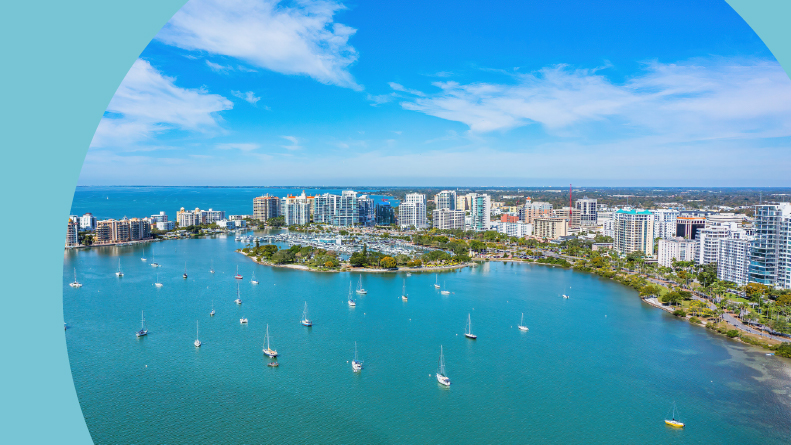
Just a little south of Tampa Bay lies the Sarasota and Bradenton area, situated directly on the Gulf Coast and offering easy access to neighboring cities via Interstate 75. Some of the best beaches are found along this stretch of the state, and there’s also art, culture, golf, and lots of shopping and dining.
Pros to Living in Sarasota-Bradenton
Popular public beaches like Siesta Key in Sarasota and Coquina Beach, closer to Bradenton, aren’t just for swimming and sunbathing. These are also great spots for picnics, snorkeling, fishing, and kayaking. Residents can find a fishing charter, hunt for seashells, and join a volleyball game. Also, the art galleries and museums in this area are legendary. Not only is there the world-famous Ringling Museum, but also the Sarasota Art Museum and the Bishop Museum of Science and Nature in Bradenton.
Multiple top-rated hospitals are in the area, making it a comfortable place to live for individuals with chronic conditions to manage. Sarasota Memorial Hospital has evolved from a small community hospital to a flagship health care system in the state. There’s also Sarasota Doctors Hospital, which specializes in behavioral health, women’s care, wound care, and robotic surgery.
Additionally, numerous active adult communities can be found in this area, which provides a sense of inclusion and intimacy among active adults seeking social events, communal classes, and activities such as pickleball, tennis, and golf.
Sarasota-Bradenton’s Coastal Lifestyle
It’s not so easy to find a walkable city in Florida, but Sarasota comes as close as any city can. The downtown district is filled with shopping, art galleries, theaters, local boutiques, restaurants, breweries, wine bars, and outdoor farmers’ markets, as well as entertainment. Main Street runs all the way to the water and Bayfront Park.
The coastal lifestyle in Sarasota and its neighbor, Bradenton, really balances out cultural sophistication. An entire day could be spent on the water, and then the evening could mean a performance at the Sarasota Opera House or strolling around the shops at St. Armand’s Circle.
In this part of Florida’s Gulf Coast, there’s a balanced mix of full-time residents and part-time snowbirds. Many part-timers ultimately become full-time Floridians when they’re ready to embrace retirement fully. This creates a rich and diverse culture of older adults who share similar interests and lifestyles.
Housing Options in Sarasota-Bradenton
When it comes to choosing where to live in Sarasota-Bradenton, active adults can opt for large, lifestyle communities featuring multiple pools, fitness centers, clubhouses, and walking trails. Alternatively, they can find smaller, quieter communities that may offer more serenity than urban society. Neighborhoods like Lakewood Ranch offer a touch of luxury, featuring gated communities, single-family homes with private outdoor spaces, and access to golf courses and onsite retail shops.
There are also attached villas, small cottage homes, and low-maintenance condos available in a range of price points. Bradenton and Bradenton Beach offer golf course living and lakeside condos. Smaller towns in the area, such as Parrish and Palmetto, can offer additional affordability and easy proximity to Sarasota and the Gulf beaches.
Additional Resources:
- Is Sarasota, Florida a Good Place to Retire?
- Moving to Sarasota? Here’s Everything Retirees Need to Know
- Sarasota vs. Fort Myers: Which Is Better for Your Retirement?
- Exploring the 55+ Communities in the Sarasota-Bradenton Area
- The Most Affordable Retirement Communities in Florida
- The Best West Coast Florida Beaches for Retirement
- The Best Lowest-Priced 55+ Communities in Sarasota and Bradenton
Fort Myers-Cape Coral Area
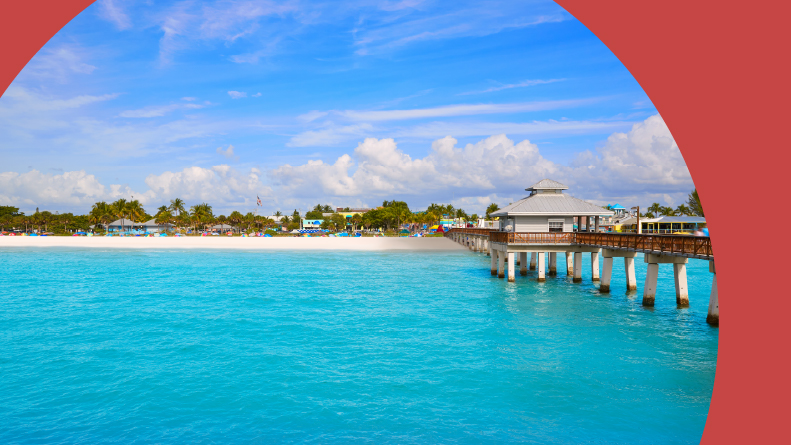
Active adults looking for a more affordable way to retire on Florida’s Gulf Coast will want to explore the Fort Myers and Cape Coral communities. These areas are south of both Tampa and Sarasota, but north of Naples. They don’t draw the large crowds of other, more populous Gulf Coast communities, but the residents don’t mind. They like the peace and the relative quiet.
What to Love About Fort Myers-Cape Coral
This is a picturesque part of Florida that features canals and parks, celebrates boating and canoeing, and offers a relaxed atmosphere that also includes plenty of opportunities for outdoor recreation, cultural entertainment, and year-round sporting events. This is an especially desirable area for snowbirds, and the full-time population has been growing steadily. Residents will find affordable homes, ample water resources, and lower tourism levels compared to other nearby cities.
Cape Coral has approximately 400 miles of canals, a feature that is not widely known among people outside the area. About 295 miles of canals are freshwater, and 105 miles offer direct access to the Gulf. There are residential homes along the canals, offering numerous opportunities to launch a boat, kayak, or jet ski.
Fort Myers-Cape Coral Local Lifestyle
Imagine a laidback lifestyle that’s heavy on the beach, the boats, and the soaking up of local nature. We’re talking about birdwatching, wildlife photography, kayaking, canoeing, and long days of fishing. Invest in a collection of sun hats or baseball caps. Buy the sunscreen in bulk.
Golf is another popular activity in the Fort Myers-Cape Coral area. In North Fort Myers, Heron’s Glen Golf and Country Club is a popular spot, and people also love Coral Oaks in Cape Coral. Farmers’ markets and outdoor concerts are enjoyed year-round, and spring training baseball arrives in February. The Minnesota Twins and the Boston Red Sox both train in Fort Myers, bringing fans to watch practices and games. Other events to look for include the Fort Myers Beach Shrimp Festival and the American Sand Sculpting Championship.
Fort Myers-Cape Coral Housing Choices
Look for budget-friendly 55+ communities in Fort Myers and Cape Coral. Not only are the asking prices lower, but the homeowners’ association (HOA) fees are considerably less expensive than those in larger cities. Active adults will find waterfront homes, townhomes, and condos, as well as new construction communities a bit more inland.
Additional Resources:
- 7 Popular Gated Communities in Fort Myers
- Fort Myers Communities Offering New Construction Homes
- Discover the 55+ Communities of Fort Myers, FL
- Sarasota vs. Fort Myers: Which Is Better for Your Retirement?
- Moving to Fort Myers? Here’s Everything Retirees Need to Know
- Affordable Retirement Communities in the Fort Myers Area
- The Best Communities in Fort Myers, Florida
- The Most Affordable Retirement Communities in Florida
- The Best Lowest-Priced 55+ Communities in Fort Myers & Cape Coral, FL
Naples-Bonita Springs Area
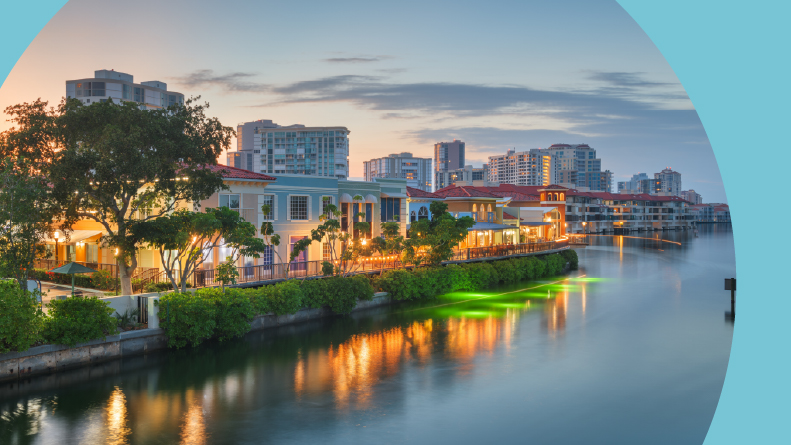
When luxury is the only option for retirement, Naples and its neighboring communities, such as Bonita Springs, can provide a great starting point. This is one of the best places to retire on Florida’s Gulf Coast for anyone who looks forward to fine dining, upscale shopping, and well-landscaped, gated neighborhoods with every imaginable amenity.
Reasons to Love Naples-Bonita Springs
Naples is consistently ranked one of the best places to retire in the U.S. That might be because everything here is pretty, pleasant, and completely possible. The lovely beaches are well-appointed, offering rental umbrellas and chairs, as well as accessible restrooms and places to purchase snacks. Waterside Shops features luxury brands such as Gucci, Hermès, Carolina Herrera, and Louis Vuitton. Additionally, The Village Shops offers not only great shopping but also fantastic dining experiences right on the water.
Wellness is a major focus in this part of Florida, and it’s easy to find yoga, Pilates, and boxing classes, as well as concierge-style gyms and fitness centers offering group classes and personal training. Traditional hospitals, like Physicians Regional, are joined by carefully curated wellness centers, such as NCH Wellness and OMNI Balanced Life Center, which offer a range of services, including traditional and holistic options like massage and acupuncture.
Naples-Bonita Springs Lifestyle Goals
Life can be as quiet or as active as retirees want it to be when living in Naples. There’s an elegance to the streets, the shopping, and even the shoreline. Residents are passionate about nature and make a conscious effort to protect it. Clam Pass Park is a protected habitat for birds, turtles, and marine mammals, while Naples Botanical Gardens cover 170 acres.
Most people who live in this part of Florida enjoy their sunsets, get their exercise, and take good care of themselves. From fall until spring, there’s a schedule of art festivals, including Art Fest Naples and Art in the Park. Bonita Springs hosts a boat show, a holiday stroll, and the annual Bonita Springs Seafood and Music Festival. Golf club memberships are pretty standard, and Bonita National Golf and Country Club is a local favorite.
Where to Live in Naples-Bonita Springs
While budget-friendly features can be found, this part of Florida’s Gulf Coast is best reserved for those active adults who seek exclusivity, extra amenities, and refined options when it comes to things like restaurants, services, and shops. Gated 55+ communities within master-planned communities are common, and we also see waterfront condos with higher price tags and single-family homes in golf course and country club-style neighborhoods.
Additional Resources:
- Is Naples Florida a Good Place to Retire? Here’s What You Need to Know
- Tour the Best Low-Priced Retirement Communities in Naples, FL
- The Best Communities for Staying Active in Naples, FL
- The Best Golf Communities in Naples, Florida
- Luxury 55+ Communities in Naples, Florida
Venice-Port Charlotte-Punta Gorda Area
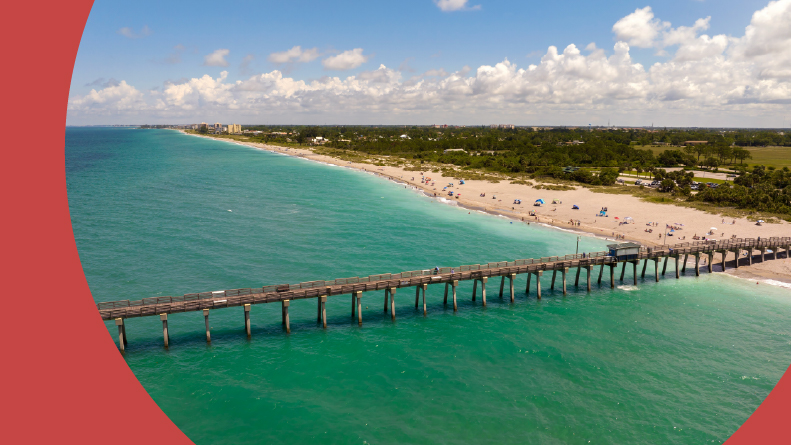
Shark teeth and shells on the beach, canals winding through the residential neighborhoods, and the small-town charm that’s hard to find in other Gulf coast cities can be enjoyed in areas such as Venice, Port Charlotte, and Punta Gorda. These communities, located south of Naples, are significantly more affordable than their northern neighbor.
Best Parts of Venice-Port Charlotte-Punta Gorda Area
Residents here love the peaceful way of life, the pretty strolls and sunsets that are possible on the beach or beside the canals, and the serenity only a seaside town can provide. It’s more affordable than hotspots like Naples or Sarasota, and there’s a high population of retirees and active adults. Boating is a popular hobby and residents also enjoy fishing, shelling, and other beach activities.
What Life Is Like Is Venice, Port Charlotte, and Punta Gorda
Downtown areas are walkable, with antique shops, restaurants, art galleries, cafes, and parks. Heritage Park in Venice leads from the downtown area right to the beach. In Punta Gorda, Harborwalk is a walking and biking path that runs to Fishermen’s Village, which is full of shops and waterfront dining opportunities. Over the course of these two miles, there will be splendid views, mangrove forests, and the chance of seeing wading birds and dolphins. Also, the Tampa Bay Rays have their spring training baseball facility in Port Charlotte.
This is an ideal spot for retirees interested in nature. The beaches in Venice are a huge draw, not only for sunbathing and swimming, but also for the natural, less-developed feel along the coast. In Port Charlotte, Charlotte Harbor Preserve State Park contains five aquatic preserves, and Babcock Ranch Preserve is a vast ecosystem that is good for hiking, wildlife watching, and fishing. Anyone looking for a quiet, low-key approach to retirement will find an easy home in Venice, Port Charlotte, and Punta Gorda.
Where to Live in Venice-Port Charlotte-Punta Gorda Area
Homebuyers interested in canal homes with water views and access have some good options in Punta Gorda. Resale homes are available in 55+ communities there, and affordable single-family homes, condos, and attached villas can be found in neighborhoods throughout Port Charlotte.
Additional Resources:
Panama City-Pensacola Area (Northwest Gulf Coast)

Heading north, Florida’s Gulf Coast includes Panama City and the Pensacola area. This is located in the Panhandle, near the Alabama border. Life here is more seasonal. Winters are a bit cooler, but still manageable. The cost of living is lower than in other parts of Florida, and the quality of life is high.
Pros to Northwest Gulf Coast Living
This is a highly affordable place for retirement, especially considering that property taxes are exceptionally low. It’s known as the Emerald Coast, thanks to its clear, green water and white sand beaches. This part of Florida is especially military-friendly, with four major military installations in Pensacola and three in Panama City. Veteran services are strong in this area, and there’s a naval hospital in addition to several VA clinics and emergency care centers.
Life on the Northern Gulf Coast
For many residents and visitors, this part of the state feels less like the rest of Florida and more like the Deep South. Locals pride themselves on a sense of southern hospitality, and while summer seasons get touristy, there’s a year-round sense of small-town charm and supportive community relationships. The pace is quiet, reserved, and authentic.
National and state parks here are a treasure. Gulf Islands National Seashore is worth a visit, and St. Andrews State Park in Panama City is popular for snorkeling and scuba diving. Fishing piers and boat launches are easy to find, and Pensacola has several yacht clubs and marinas. Aviation history is also a significant part of the area. Pensacola is the home of the Blue Angels, which is the U.S. Navy’s flight demonstration squadron, and the National Naval Aviation Museum.
The populations of both Pensacola and Panama City, as well as the surrounding beach towns, are significantly lower than those of other Florida cities. It’s easy to become part of the community, make new friends, and explore existing and new interests.
Where Active Adults Can Live on the Northern Gulf Coast
With the cost of living a bit lower in Northern Florida, homes are affordable and available in 55+ communities around Pensacola and Panama City. There are budget-friendly condos and townhomes, as well as single-family homes with more space. While the inventory of 55+ communities is lower here, the growing interest in Northwest Florida as a retirement destination is spurring new development.
Additional Florida Gulf Coast Resources:
- Retiring on Florida’s Gulf Coast: Best Places, Costs, and 55+ Living (2025)
- Where to Retire on Florida’s Gulf Coast: Southwest vs. Northwest Florida
- Coastal Retirement Bliss: 10 Reasons to Buy a Home on Florida’s Central Gulf Coast
- Is It Better to Retire to Florida or North Carolina?
- South Carolina vs Florida: Which Is Better for Retirement?
- Georgia vs Florida: Which Is Better for Retirement?
- Best Beach Retirement Towns in Florida: Find Your Ideal Spot
- Is It Better to Retire on the East or West Coast of Florida?
- Arizona vs. Florida: Which Retirement Destination Is Right for You?
Housing on the Gulf Coast: Options, Costs & Communities
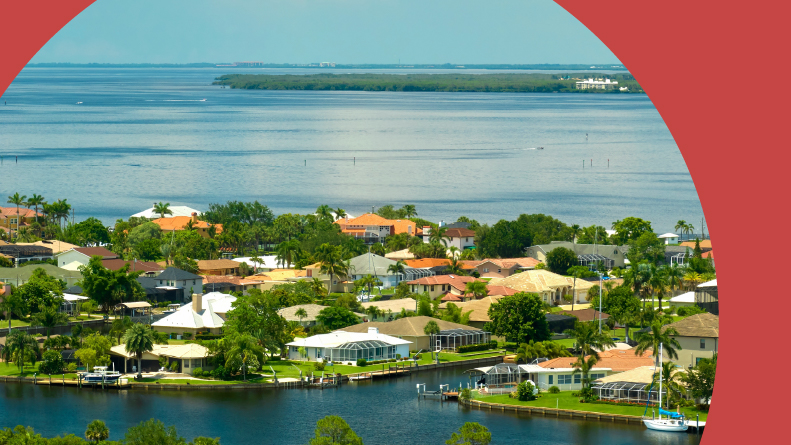
When it comes to finding a home on Florida’s Gulf Coast, many active adults choose a 55+ community. And it’s easy to understand why.
Why Retirees Love 55+ Communities
- Age restrictions in 55+ communities ensure retirees are living among peers.
- Many communities have gated entries, providing an extra layer of security and safety, particularly for part-time residents and snowbirds.
- Amenities are provided that facilitate social activities and community events. There are often clubhouses, pools, fitness centers, pickleball courts, and walking paths.
- HOAs provide for a low-maintenance lifestyle, taking care of landscaping and lawn care.
Not all 55+ communities are alike. There’s plenty of diversity, and buyers can find condos, single-family homes, attached villas, ranch homes, manufactured homes, and townhouses. Many communities offer single-story floor plans, while mid-rise or high-rise condo buildings typically feature elevators.
Also, lifestyle directors and activity directors can often be found in 55+ communities. There’s a sense of community, a support network among neighbors, and a commitment to keeping the neighborhood attractive, clean, safe, and welcoming.
Some of the areas along Florida’s Gulf Coast with the highest density of 55+ communities include Sarasota, Naples, Fort Myers, and Tampa suburbs like Sun City Center and Land O’Lakes.
“When people think of retiring on Florida’s Gulf Coast, they often imagine endless beaches and perfect sunsets. What many don’t immediately see is how many 55+ communities are snug in small towns with strong social ties and local amenities that rival larger cities.”
-Khadeejah Johnson, Associate Vice President of Brokerage & Partnerships at 55places.com
Additional Resources:
Choosing Waterfront and Marina Communities
Boating and fishing lifestyles in Naples, Cape Coral, Venice, and Gulfport make waterfront communities an excellent option for anyone moving to Florida with a boat, kayak, canoe, or an interest in spending more time on the water. Homes on canals often come with their own docks, and even larger communities on Tampa Bay or with access to the Gulf might have community docks and marinas. Fishing piers are often a standard amenity found in waterfront communities.
HOA fees may be higher for waterfront homes, or a separate marina fee may be required for homeowners who need to store or launch a boat. Most of these homes will include a separate outdoor space. A patio or a screened lanai is a fantastic place to enjoy a view of the water.
Additional Resources:
Deciding Between New Construction and Resale Homes
Numerous new 55+ communities and homes can be found along Florida’s Gulf Coast, thanks to a rise in demand. There has been significant development and interest from builders specializing in active adult communities. There are advantages and drawbacks to new construction homes, and sometimes resale is the better option, especially for buyers who find exactly what they’re looking for in a home that’s been around for a few years.
New Construction
One of the best reasons to choose a new construction home is that modern systems and features are already included. This means energy efficiency, smart home technology, open and contemporary layouts, and a sense that major repairs won’t be needed for quite some time. Buying a new construction home also provides an opportunity to make some customized choices, whether that’s selecting your own appliances, paint color, or countertops. Builder incentives are also available when buying new; you may be eligible for assistance with closing costs or complimentary upgrades.
Expect to pay more for new construction homes. There’s generally a higher cost per square foot. The timeline for closing and moving in might be a bit longer, too, and even if you’re one of the first to move into your newly developed home, expect to hear and see construction going on around you for a while. These communities are often in less-developed areas as well. Active adults are unlikely to find a new construction home in downtown St. Petersburg or Sarasota.
Resale Homes
A resale home may be the better option. The price tags are likely to be lower, and the sense and spirit of the neighborhood will already be established. Instead of empty lots and construction equipment, there will be mature landscaping, fewer disruptions, and residents who have lived there for years. It can be a comfort to someone who is just moving in. Speaking of moving in, buyers can likely do it sooner with a resale home. There’s no need to wait for the construction to be completed.
These homes are also older, however. There may be some upgrades and updates that are needed to make the house more modern and accommodating. The resale home market can also be more competitive in certain areas, particularly in metro regions such as Tampa and Naples.
Additional Resources:
Home Prices and Rental Values on Florida’s Gulf Coast
With so many people moving to Florida over the last five years, and the state remaining the top destination for snowbirds for part of the year, home prices have risen recently. Rents have, too. For those coming to Florida temporarily ahead of retirement or for part of their retirement, the pricing will depend on the type of seasonal rental that’s chosen. There are:
- condos in buildings and communities that have a large population of snowbirds
- apartments rented by the month
- furnished homes in 55+ communities are leased for specific periods of time
- short-term vacation rentals, like those found on Airbnb, VRBO, and similar sites
The typical snowbird rental season runs from October through April. It’s possible to find something for six or seven months, and it’s also easy enough to rent for a month or two, or even three. Flexibility and convenience are often provided in professionally managed rental units.
It’s important to remember that prices are going to depend largely on:
- Proximity to the water – This could be the coast, but also lakes, rivers, and canals. Any home that has access to water or a view of water is likely to cost more.
- Amenities – Swimming pools, fitness centers, and pickleball courts attract more buyers, leading to increased prices.
- Age – New construction will be higher than homes that are several decades old.
- Community type – Golf course communities and country club vibes will mean a higher sales price.
“One of the things our data consistently shows is that home prices in 55+ communities on Florida’s Gulf Coast are often more affordable here than many retiree-heavy areas in the Northeast, meaning your retirement dollars go further without sacrificing quality of living.”
Additional Resources:
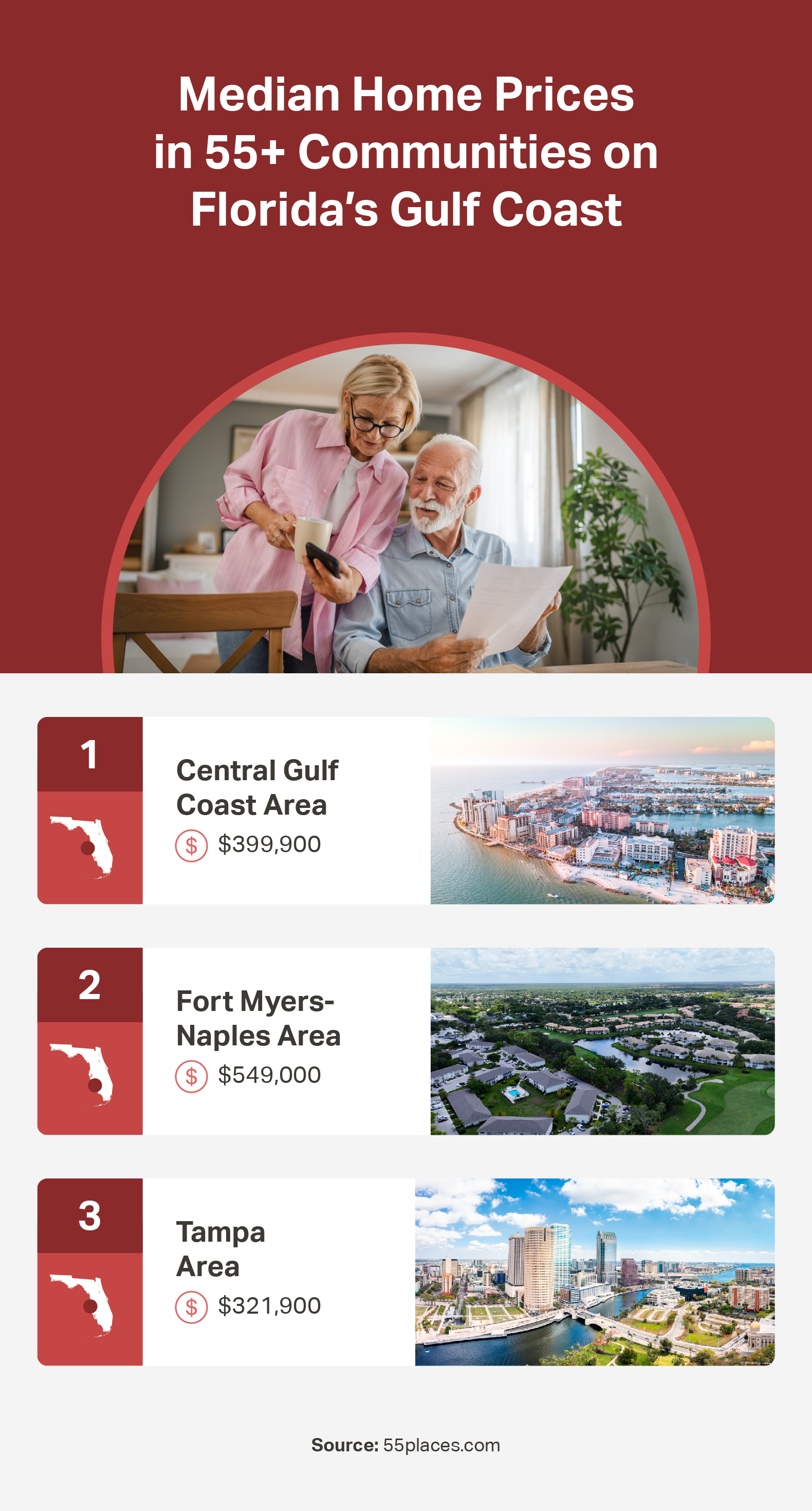
Beyond the Purchase Price: HOAs and Insurance
Living in a community with an HOA or condo association can be beneficial for many reasons. Property values tend to remain high, and someone else handles the weeding and mowing. Additionally, there are security and amenity upkeep costs that contribute to a safe and attractive neighborhood.
HOA dues, however, must be included in any homeowner’s budget. They’re generally between $200 and $600, unless we’re talking about a luxury community or one that provides for extra fees, such as greens fees in a golf community or marina fees in a waterfront neighborhood.
Homeowners Insurance
In Florida, there is an especially urgent need for good homeowners’ insurance. Retirees from other states are often surprised and confused by the process of obtaining insurance for their retirement home in Florida. The threat of hurricanes and litigation led many insurers to leave, causing problems for homeowners when it came time to buy or renew a policy.
Recent changes in state legislation have stabilized the market, making it less expensive and reducing rates, specifically for those insured by Citizens Property Insurance, a not-for-profit, tax-exempt, government entity that provides property insurance to eligible Florida property owners.
Flood Insurance
Flood insurance may be necessary if you buy a property in a flood zone. This extends well beyond coastal regions. Rivers can also pose a significant flood risk, especially during storm surges. Before buying, check if the home is in a Coastal A Zone. This indicates an area most affected by coastal flooding from storm surges and tides.
For most Florida residents, flood insurance is a separate policy that needs to be purchased. In other cases, the homeowners’ insurance company that insures a property will include flood coverage as an additional rider. The state’s Insurance Consumer Advocate offers several resources on determining the necessary type of coverage, filing a flood claim, and taking steps to recover from a water event.
Hurricane Risk
Because of the hurricane risk, the Florida Building Code requires that new residential buildings must meet certain elevation standards. They must have an elevation at or above the Base Flood Elevation (BFE) plus one foot, or the Design Flood Elevation (DFE), whichever is higher. The BFE is the elevation to which floodwater is predicted to rise during a 100-year flood. The DFE describes the elevation to which a structure must be elevated, as defined by the local floodplain management ordinance, and may be higher than the BFE.
Additional Resources:
- Benefits of an HOA: Why 55+ Homebuyers Want a Homeowners’ Association
- Buying a Home With or Without an HOA
- Everything You Need to Know About a 55+ Community HOA
- Homeowners Insurance for Seniors: A Comprehensive Guide
- Understanding Florida Homeowners Insurance: What to Expect and How to Prepare
Cost of Living, Health Care & Local Services
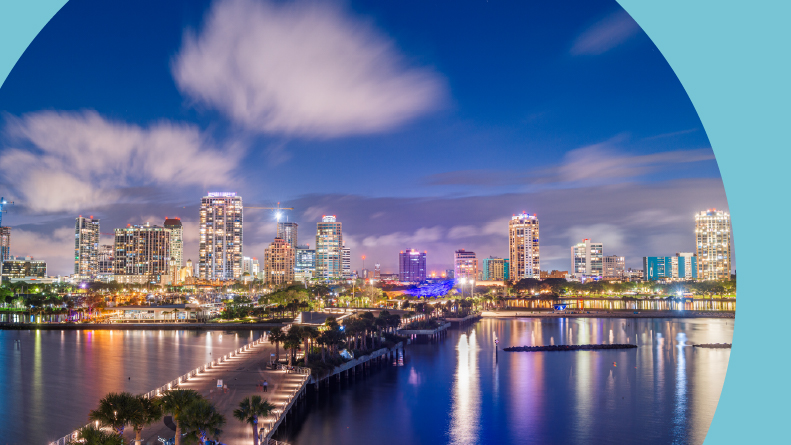
Cost of Living
So, where does Florida’s Gulf Coast land, in terms of cost of living? We’re examining the average prices of groceries, entertainment, utilities, and transportation. Here’s what those costs look like in each of the regions we’ve covered.
Tampa Bay Area
Tampa’s cost of living is about 4.1% higher than the national average, but 1.1% lower than Florida’s state average. Groceries tend to cost more on average, but utility costs are lower than the U.S. median.
Sarasota-Bradenton Area
In Sarasota and Bradenton, expect a cost of living that’s 5.3% higher than the national average and about 2.2% higher than the Florida average. Home prices are exceptionally high, particularly in Sarasota.
Fort Myers-Cape Coral Area
In Fort Myers, the cost of living is around 4.2% higher than the national average and just 1.1% higher than Florida’s state average. Notably, housing costs in Fort Myers are lower than the national or state average.
Naples-Bonita Springs Area
As expected, the average cost of living in Naples is 13% higher than the U.S. average and 9.6% higher than the Florida average. Outside of Naples, things are more comfortable. The cost of living in Bonita Springs is still higher than the national or state averages, but by a much lesser amount.
Venice-Port Charlotte-Punta Gorda Area
The costs of living in Venice and the surrounding coastal areas are generally than the rest of the country. It’s 2.1% higher than the state average. Port Charlotte, however, is 6.3% lower than the national average and 9.1% lower than the state average.
Panama City-Pensacola Area (Northwest Gulf Coast)
The cost of living in Panama City is attractive, with a 4.6% lower rate than the national average and a 7.5% lower rate than the Florida average. Pensacola numbers are even better. The cost of living is 11% lower than the national average and 13.7% lower than the state average.
Additional Resources:
- How Much Does It Cost to Retire in Florida?
- Understanding Florida Homeowners Insurance: Where to Expect and How to Prepare
- Can I Retire in Florida on $3,000 a Month?
- How Long Will $1 million Last in Retirement in Florida?
- Social Security Changes for Florida Retirees in 2025
- Best Places to Retire in Florida on a Budget
- Luxury Retirement Communities Florida
- 55+ Communities in Florida Under $100,000 With Homes for Sale
- Best Lowest-Priced Communities in Florida (With Low HOA Fees)
Health Care on Florida’s Gulf Coast
Florida understands its population, which explains the numerous high-quality hospitals and healthcare providers throughout the state and along the Gulf Coast. Senior Care is a specialty in facilities such as Tampa General Hospital, which has an excellent Geriatric ward and is well-known for its Trauma Center and treatment of brain and spinal cord injuries.
Medicare Advantage is the health insurance most retirees use, and it is widely accepted in hospitals along Florida’s Gulf Coast. These plans combine Original Medicare benefits (Parts A and B) and often include prescription drug coverage (Part D) along with additional benefits such as vision, dental, and hearing benefits. Some popular providers in Florida include:
- Aetna
- Cigna
- Humana
- UnitedHealthcare
- Wellcare
It’s not just health insurance. In Florida, wellness is holistic and comprehensive. It’s a lifestyle. Many Medicare Advantage plans include a range of wellness services, including fitness programs, gym memberships, and services related to mental health, chronic disease management, and preventive care.
Top Hospitals
Several of Florida’s best-ranked hospitals are located on the Gulf Coast:
- Moffitt Cancer Center in Tampa, ranked first in Florida for its cancer treatment, prevention, and clinical trials
- Tampa General Hospital, ranked nationally in specialties such as cancer, cardiology, and diabetes
- Sarasota Memorial Hospital, highly ranked for gastroenterology, orthopedics, and urology
- Lee Memorial Hospital in Fort Myers, highly ranked in nephrology and gynecology
- NCH Baker Hospital, in Naples, ranked as high performing for its back surgeries and stroke care
Veterans can access exceptional care in the Tampa Bay area, which boasts the nation’s largest federal rehabilitation facility, as well as on the North Gulf Coast, in Panama City and Pensacola.
Additional Resources:
- 55+ Communities Near the Best Hospitals in Florida for Seniors
- The Best Places to Retire for Health Care
- How Do 55+ Communities Handle Health Care and Emergency Services?
Talking About Taxes
The good news is that a retirement on Florida’s Gulf Coast means there will be no state income taxes. That includes any Social Security income or other retirement income. There’s no inheritance or estate tax, either, which is especially beneficial for retirees hoping to preserve and pass on some generational wealth to family members and other heirs.
The statewide sales tax is 0.6%. Different counties may attach their own local surtax to that state amount, which means that the overall sales tax consumers in Florida might pay could go up to 7.5%.
Property taxes are determined at the county level. Gulf Coast counties with the lowest property tax rates are:
- Walton County (Emerald Coast communities in the north like Santa Rosa Beach and Paxton)
- Franklin County (Panhandle areas like Apalachicola)
- Citrus County (Just north of Tampa, inclusive of Homosassa Springs and Crystal River)
- Escambia County (Pensacola)
- Taylor County (North Florida, near the state’s Big Bend, with communities like Perry and Steinhatchee)
There’s property tax relief available through Florida’s Homestead Exemption. There’s also a 3% per year cap on assessed value increases through the Save Our Homes program. This applies only to primary residences.
Here’s how this looks. Let’s assume:
- Your property is worth $300,000.
- If you qualify for the Homestead Exemption, you reduce the taxable value of your home by $25,000. Now, it’s valued at $275,000.
- The next $25,000 that you can deduct from your property value applies to the assessed value between $50,000 and $75,000 and applies to all taxes except those for school districts. Your taxable property value is now $250,000.
This reduction in taxable value directly leads to lower property tax bills.
Additional Resources:
Is Gulf Coast Retirement Right for You?
Florida’s Gulf Coast has a place to call home for beachgoers, boaters, and people who love the arts. Retirees can enjoy golf, fishing, and fine dining while shopping and strolling. If you love the sunshine and can tolerate the heat and humidity, this might be your perfect destination.
This is not your retirement destination if you love the mountains, playing in the snow, or your fixed income is on an extreme budget. This is not the place for people with storm anxiety, either. Even the late afternoon thunderstorms can be intense. Looking for big waves and heavy surf? The Atlantic side of the state might be more your speed. The Gulf is renowned for its warm, calm waters.
If you want to know for sure that the Gulf Coast is where you want to be, we recommend:
- Visiting during the summer. You’ll get a taste of how hot it can get.
- Consider a seasonal rental to get a feel for the traffic, prices, and planned activities.
- Check out homeowners’ insurance costs before you buy.
- Speak with individuals who have experienced recent hurricanes.
“Retirement isn’t one size fits all. On the Gulf Coast, you’ll find everything from low-maintenance condos near the water to full-scale 55+ resort communities with wellness, golf, and social programs. It’s about matching lifestyle to budget and priorities.”
-Bill Ness, Chief Executive Officer, Founder, & Illinois Managing Broker at 55places.com
Quick FAQs About Retiring on Florida’s Gulf Coast
1. What are the most popular Gulf Coast cities for retirees?
A substantial population of retirees can be found in cities along Florida’s Gulf Coast, such as Sarasota, Naples, and Fort Myers. These cities are popular for their activities, 55+ communities, and opportunities for recreation and entertainment.
2. Is the Gulf Coast more affordable than other parts of Florida?
That depends. Some areas like Naples and Sarasota are more expensive, while Tampa and Pensacola have a lower cost of living than Florida’s average.
3. What’s the weather like on Florida’s Gulf Coast?
Summers are hot and humid, while winters, for the most part, are mild. There are occasional cold spells, especially along the North Gulf Coast cities in the Panhandle.
4. Are there many 55+ communities on the Gulf Coast?
Yes. Because the population of retirees has grown so much in the last five to seven years, there are a lot more communities for active adults on this side of Florida. Many are still being constructed.
5. How does the cost of living compare to the national average?
Florida’s Gulf Coast has a cost of living that’s slightly higher than the national average, unless you’re in the Panhandle and areas like Pensacola and Panama City.
6. Is health care easily accessible on the Gulf Coast?
Yes. A number of nationally ranked hospitals are in cities like Tampa, Fort Myers, Sarasota, and Naples.
7. Do I need flood or hurricane insurance?
Yes. Thanks to hurricane risk, homeowners insurance can be expensive. You’ll need to be covered, though, and if you’re in a Coastal A Zone, flood insurance is required.
8. What’s the difference between the Gulf Coast and the Atlantic Coast for retirement?
The Gulf Coast enjoys a slower pace of life, and there’s less tourism than the Atlantic side. Cities are smaller, many costs tend to be a bit lower on the Gulf Coast, and the waters in the Gulf are calmer and warmer than those in the Atlantic.
9. Is the Gulf Coast a good place for snowbirds?
Florida’s Gulf Coast is an excellent place for snowbirds. It’s easily accessible by Interstate 75, there’s an international airport in Tampa, and many 55+ communities offer “lock and leave” programs, ensuring homes remain secure and maintained while vacant.
10. How much does a typical home in a Gulf Coast 55+ community cost?
There’s a wide range of prices. Waterfront homes in new construction resort communities can cost over one million dollars, while affordable condo homes in smaller areas can be bought for less than $200,000. The price depends mainly on location and property type. The majority of homes on Florida’s Gulf Coast will land somewhere between $250,000 and $500,000.
Finding Your Perfect Retirement on Florida’s Gulf Coast
Retiring along Florida’s Gulf Coast offers endless possibilities—from charming small towns with a laid-back coastal vibe to vibrant cities filled with culture, dining, and entertainment. Whether you’re drawn to the affordability of certain areas, the luxury of waterfront living, or the lifestyle of a 55+ active adult community, there’s a perfect spot waiting for you.
With so many choices, it can be overwhelming to know where to start, but you don’t have to do it alone. The trusted experts at 55places.com can help you explore your options, compare communities, and connect with a local agent who understands your retirement goals. Let us guide you to your dream home on Florida’s Gulf Coast so you can begin the next exciting chapter of your life with confidence.

